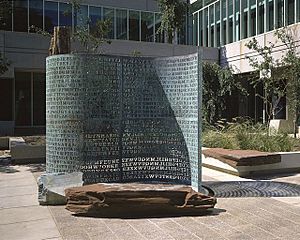Jim Sanborn facts for kids
Quick facts for kids
Jim Sanborn
|
|
|---|---|
| Born |
Herbert James Sanborn, Jr.
November 14, 1945 Washington, D.C., United States
|
| Known for | Sculpture |
|
Notable work
|
Kryptos, Critical Assembly |
| Partner(s) | Jae Ko |
Herbert James Sanborn, Jr. (born November 14, 1945), known as Jim Sanborn, is an American sculptor. He is most famous for creating Kryptos, a sculpture with a secret coded message at the headquarters of the Central Intelligence Agency (CIA) in Virginia.
Contents
Early Life and Education
Jim Sanborn was born in Washington, D.C.. His father was in charge of exhibits at the Library of Congress, and his mother was a concert pianist. Growing up, he attended schools in Virginia.
For college, Sanborn studied many different subjects. He earned a degree in paleontology (the study of fossils), fine arts, and social anthropology (the study of human societies). Later, he earned a Master's degree in sculpture. He also taught art at a college and was an artist-in-residence at Glen Echo Park for nine years.
Artistic Style and Themes
Sanborn's art has been shown in famous museums like the High Museum of Art in Atlanta and the Hirshhorn Museum and Sculpture Garden in Washington, D.C. He has also made large sculptures for places like the Massachusetts Institute of Technology (MIT) and the National Oceanic and Atmospheric Administration (NOAA).
A major theme in his work is "making the invisible visible." Many of his sculptures explore hidden forces and ideas, such as:
- Magnetism: The natural force that makes magnets stick to metal.
- The Coriolis Effect: An invisible force that affects the movement of things on a spinning planet like Earth.
- Secret Messages: Using codes and cryptography to hide information.
- Atomic Reactions: The mysterious science behind atoms and energy.
Famous Sculptures
Sanborn has created many amazing sculptures that combine art with science and history.
The Mystery of Kryptos

Kryptos is probably Sanborn's most famous work. Unveiled in 1990, this sculpture stands outside the CIA headquarters. It is made of a large, curving copper screen covered in 2,000 letters.
But these aren't just random letters. They form four secret messages written in code. For over 30 years, codebreakers, detectives, and puzzle fans have tried to crack them. So far, only three of the four messages have been solved. The final section, made of just 97 characters, remains a mystery.
Sanborn has said that if he passes away before the code is fully solved, he has left clues behind so someone can check the final answer. The sculpture is so well-known that it was even featured in the Dan Brown novel The Lost Symbol.
Other Major Works
Critical Assembly
This powerful exhibit from 2003 explores the science of atomic energy. It features a sculpture that looks like the parts of an early atomic bomb. The artwork, called Critical Assembly, shows a disassembled sphere that was designed to hold nuclear material like plutonium and uranium. The piece was inspired by the Manhattan Project, the secret U.S. program that developed the first atomic weapons during World War II.
Terrestrial Physics
For this 2010 exhibit, Sanborn built a working particle accelerator. A particle accelerator is a machine that speeds up tiny atomic particles to very high speeds. Sanborn's machine used a device called a Van de Graaff generator to create a huge electrical charge of one million volts. This allowed the sculpture to actually cause nuclear fission (the splitting of atoms).
Coastline
Located at the National Oceanic and Atmospheric Administration (NOAA) headquarters, Coastline is an interactive outdoor sculpture. It recreates a part of the Atlantic coast. What makes it special is that the waves in the sculpture move in "real time." A station in Woods Hole, Massachusetts, sends live data about the ocean's waves, and the sculpture copies them.
Indian Run Park
Sanborn also designed a park next to a courthouse in Beltsville, Maryland. The park is inspired by the Iroquois people who lived in the area almost 900 years ago. The park includes a waterfall and a path that follows the route of an old river called Indian Run.
As part of the art, Sanborn "seeded" the park with 10,000 arrowheads he made. This allows visitors to find and take home a small piece of the artwork. There is also a bronze sculpture with text written in the Onondaga language, which lights up at night.
Selected Works
- Kryptos (1990): A sculpture at the CIA with four coded messages. Three have been solved.
- Coastline (1993): An outdoor sculpture at NOAA that shows real-time ocean waves.
- Cyrillic Projector (1997): A sculpture at the University of North Carolina at Charlotte.
- A,A (2004): A sculpture at the University of Houston.
- Lingua (2004): A sculpture in Washington, D.C., with historical texts.
- Critical Assembly (2003): An exhibit about the science of the first atomic bomb.
- Radiance (2008): A sculpture at Louisiana State University.
- Terrestrial Physics (2009): An exhibit featuring a working particle accelerator.

